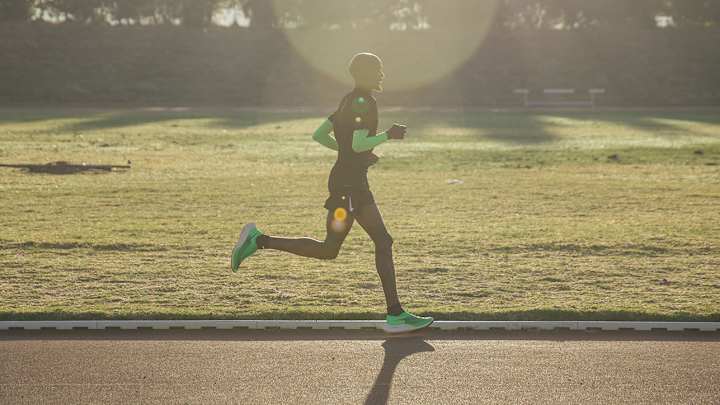Nike Unveils ZoomX Vaporfly Next% After Marathon Success With 4% Shoe

Nike has unveiled its new Zoom Vaporfly Next% shoe ahead of Sunday's London Marathon showdown where world record holder Eliud Kipchoge and four-time Olympic gold medalist Mo Farah will race in the shoes.
In 2017, Nike unveiled the Zoom Vaporfly 4% with a claim that the shoe assisted runners with a 4% improvement in running economy while compared to the Zoom Streak 6. The shoe was prominently featured as part of Nike and Kipchoge's attempt to break the two-hour marathon barrier, where he ended up running 2:00:25 for the 26.2 mile distance. The time did not count as a world record due to Nike's efforts to optimize conditions with alternating pacers and mobile fueling strategy, but Kipchoge officially broke the world record at last year's Berlin Marathon in 2:01:39.
The New York Times conducted its own study using data from fitness app Strava that determined runners in the Vaporflys clocked times that were 3 to 4% faster than similar runners in other shoes. It also found that the Vaporflys were more than 1% faster than the next-best racing shoe. The Times analyzed results from about 280,000 marathon and 215,000 half marathon performances.
At first, the Vaporfly 4% were met with controversy since some professional athletes claimed the use of carbonfiber plates in the midsole provided athletes with an unfair advantage. The International Association of Athletics Federation, track and field's governing body, determined the shoes were legal. In recent years, other shoe companies have started testing out prototypes with carbonfiber plates to close the gap on Nike's latest technological advancement.
While some may be quick to dub the shoes as the 5%'s no claim of a 5% running economy benefit has been determined. Leaked photos on prototype running shoe Instagram accounts showed models that said "0/5 Measured in the Lab. Verified with Medals and Records." The controversial carbonfiber plate is also in the Next% shoe.
The new shoe has 15% more Nike ZoomX foam than its previous edition but still weighs 6.6 ounces (on a men's size 9 shoe).
Vaporweave technology on the upper is lighter than Flyknit material and reportedly absorbs less sweat or water in rainy conditions. This was among the biggest pieces of feedback from elite athletes and the first iteration of the shoe.
According to Nike's release on the shoe, other changes include: slightly offset shoe laces to alleviate pressure on sensitive parts of the foot; a thin foam pod in the heel for Achilles relief; and some modifications to the rubber outsole traction patterns to improve grip in wet conditions. The offset was also decreased from 11mm to 8mm.
The shoe will cost $275 and will be available for purchase through the Nike NRC app on April 28. It is expected to hit stores in the summer.
Update: The top five men's finishers at Sunday's London Marathon were wearing the Nike ZoomX Vaporfly Next%. Kipchoge won the race in 2:02:37, which is the second-fastest time in history. Ethiopia's Mosinet Geremew ran 2:02:55 for second place, which is the third-fastest time in history. London was the first race with two men under 2:03:00. Kenya's Brigid Kosgei won the women's race in 2:18:20 while wearing the Nike Zoom Vaporfly 4%. Second and third place finishers Vivian Cheruiyot and Roza Dereje were wearing the Nike ZoomX Vaporfly Next%.

An avid runner, Chris Chavez covers track and field, marathons and the Olympics for Sports Illustrated.